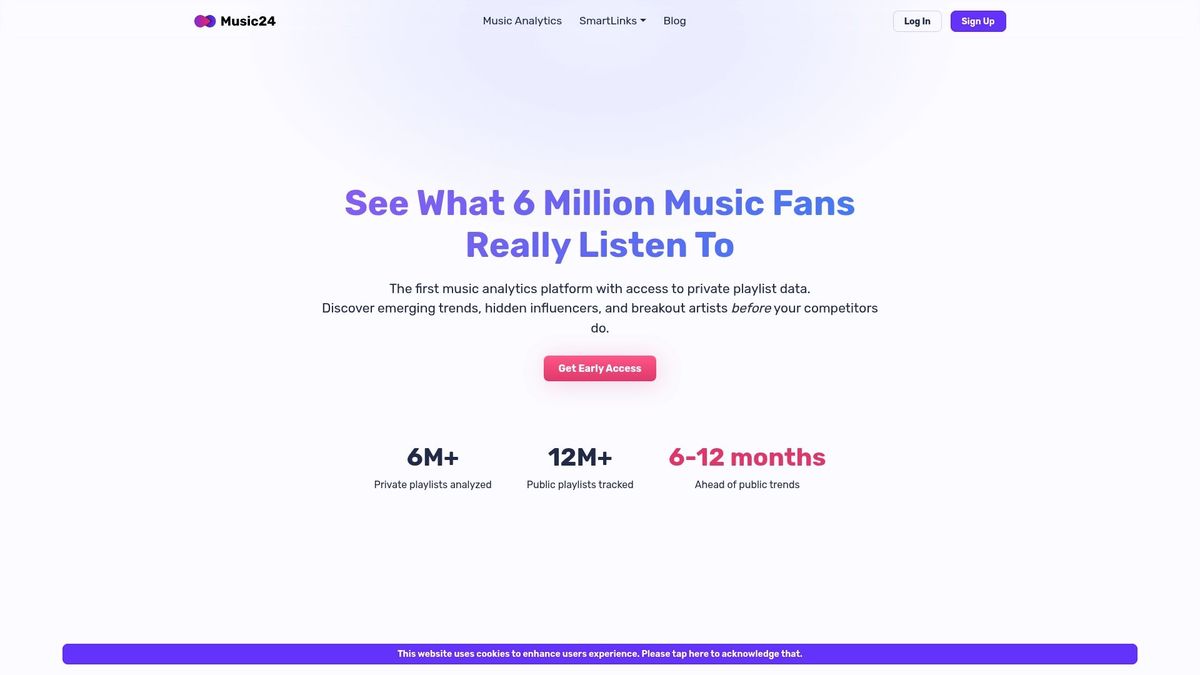Music playlists have turned into hidden treasure maps for the industry and the data behind them is changing everything. Spotify states that over 60% of all streams now come from playlists instead of direct searches or albums. That figure sounds wild and most people think playlists are just a convenient way to group songs. Turns out playlist data does way more and actually unlocks deep insights into what people will love next and even which artists might break out before anyone else sees it coming.
Table of Contents
- What Is Playlist Data And Its Components?
- Importance Of Playlist Data In Music Discovery
- How Playlist Data Influences Streaming Trends
- Key Metrics And Tools For Analyzing Playlist Data
- Real-World Applications Of Playlist Data In Marketing
Quick Summary
| Takeaway | Explanation |
|---|---|
| Playlist data reveals listener behavior. | Analyzing interaction metrics helps industry professionals understand how users consume music effectively. |
| Micro-trends can be identified through data. | By aggregating playlist data, emerging musical styles and artist potential can be predicted before they become mainstream. |
| Algorithmic recommendations shape music discovery. | Streaming platforms use playlist data to create personalized suggestions, influencing listening habits and preferences. |
| Targeted marketing strategies are empowered by playlist analytics. | Brands leverage insights from playlist data for mood-based campaigns, enhancing engagement and cultural relevance with audiences. |
| Advanced tools enhance analysis of playlist dynamics. | Sophisticated metrics and technologies allow professionals to decode complex consumption patterns and develop effective strategies. |
What is Playlist Data and Its Components?
Playlist data represents a sophisticated digital ecosystem of musical information that goes far beyond simple track listings. Research from digital music analytics platforms reveals that playlist data encompasses intricate details about musical collections, user interactions, and listener behaviors.
Structural Components of Playlist Data
At its core, playlist data includes several critical elements that provide comprehensive insights into musical consumption and trends:
- Track Metadata: Detailed information about each song, including artist name, track title, album, release year, and genre
- User Interaction Metrics: Quantitative measurements such as track skip rates, save frequencies, and replay counts
- Playlist Context: Information about playlist creation, including mood, purpose, and intended listener experience
These components work together to create a nuanced understanding of music consumption patterns.
Below is a table summarizing the core components of playlist data discussed in the article, providing a clear definition and the specific insights each component offers.
| Component | Description | What It Reveals |
|---|---|---|
| Track Metadata | Info about the song (artist, title, album, year, genre) | Musical context and catalog details |
| User Interaction Metrics | Measurements like skip rates, saves, and replays | Listener engagement and song popularity |
| Playlist Context | Details about playlist creation, intent, and mood | How playlists are curated and used by listeners |
 Playlist data transforms raw musical information into actionable intelligence for music industry professionals.
Playlist data transforms raw musical information into actionable intelligence for music industry professionals.
The Significance of Comprehensive Playlist Tracking
Playlist data serves as a critical lens through which music industry professionals can understand emerging trends, listener preferences, and potential breakthrough artists. Digital music research highlights how comprehensive playlist tracking enables predictive analysis of musical tastes and potential hit tracks.
For music industry professionals, playlist data offers unprecedented insights.
 It reveals not just what people are listening to, but how they interact with music, providing a dynamic map of musical discovery and listener engagement. Read more about playlist analytics strategies to understand how these insights can transform music industry decision making.
It reveals not just what people are listening to, but how they interact with music, providing a dynamic map of musical discovery and listener engagement. Read more about playlist analytics strategies to understand how these insights can transform music industry decision making.
By aggregating and analyzing playlist data across multiple platforms, professionals can identify micro-trends, understand genre blending, and predict potential breakout artists before they become mainstream successes. This granular approach represents a significant evolution in music industry analytics, moving beyond traditional chart metrics to a more nuanced understanding of musical consumption.
Importance of Playlist Data in Music Discovery
Playlist data has emerged as a transformative mechanism for understanding and predicting musical preferences, serving as a critical tool for music discovery and artist development. Research into digital music ecosystems demonstrates how curated playlists function as sophisticated navigation systems for listener exploration and musical taste evolution.
Bridging Artist Visibility and Listener Preferences
Playlist data provides unprecedented insights into the intricate dynamics of music consumption. By analyzing how listeners interact with different tracks, industry professionals can uncover nuanced patterns of musical discovery:
- Micro-Genre Exploration: Identifying subtle genre intersections and emerging musical trends
- Listener Behavior Mapping: Understanding how users transition between musical styles and artists
- Discovery Path Tracking: Analyzing how listeners encounter and adopt new musical content
These insights enable a more targeted approach to artist promotion and audience engagement, moving beyond traditional marketing strategies.
Strategic Implications for Music Industry Professionals
For record labels, artist managers, and music marketers, playlist data represents a powerful predictive tool. Explore our comprehensive guide on playlist analytics strategies to understand how these insights can revolutionize music industry decision making.
By examining playlist data, professionals can identify emerging artists before they hit mainstream recognition, understand regional music preferences, and develop more effective strategies for artist development. This granular approach allows for precise targeting and more intelligent resource allocation in an increasingly competitive musical landscape.
Ultimately, playlist data transforms music discovery from a passive experience into an intelligent, data-driven ecosystem where listener preferences and artistic innovation converge, creating new pathways for musical exploration and cultural connection.

How Playlist Data Influences Streaming Trends
Playlist data has become a powerful catalyst in shaping modern music streaming dynamics, transforming how listeners discover and consume music across digital platforms. Streaming platform research reveals that playlist algorithms and user-generated collections are increasingly driving music consumption patterns.
The Algorithmic Influence of Playlist Curation
Streaming platforms leverage playlist data to create sophisticated recommendation systems that significantly impact listener behavior. These systems analyze multiple dimensions of musical preferences:
- Contextual Discovery: Recommending tracks based on mood, activity, and listening history
- Genre Crossover: Identifying unexpected musical connections and expanding listener horizons
- Temporal Trends: Tracking how musical preferences evolve over time and across different user segments
By understanding these intricate patterns, streaming services can predict and shape musical trends with unprecedented precision.
Ecosystem of Musical Influence
Playlist data serves as a complex ecosystem where artist visibility, listener preferences, and platform algorithms intersect. Learn more about the nuanced types of playlist data that drive these sophisticated recommendation systems.
The cascading effect of playlist placements can transform an unknown artist into a viral sensation overnight. Record labels and artists now strategically target playlist inclusion as a critical pathway to audience expansion, recognizing that a single prominent playlist placement can generate millions of streams and significant cultural momentum.
Ultimately, playlist data represents more than just a technical mechanism—it is a dynamic cultural map that reflects and shapes contemporary musical landscapes, turning listener preferences into a powerful force of artistic discovery and promotion.
Key Metrics and Tools for Analyzing Playlist Data
Analyzing playlist data requires sophisticated metrics and advanced tools that transform raw musical information into actionable insights. Music analytics research demonstrates the complexity of extracting meaningful patterns from digital music consumption.
Critical Performance Metrics for Playlist Analysis
Music industry professionals focus on several key performance indicators that reveal the depth of playlist engagement:
- Track Retention Rate: Percentage of listeners who complete a song versus those who skip
- Cross-Playlist Migration: How frequently tracks appear across different playlist categories
- Listener Demographic Mapping: Understanding audience characteristics associated with specific musical collections
These metrics provide a multidimensional view of musical consumption beyond traditional streaming numbers, enabling more nuanced strategic decisions.
This table presents key playlist analysis metrics mentioned in the article, clarifying their definitions and the unique value each provides for music industry professionals.
| Metric | Definition | Value for Analysis |
|---|---|---|
| Track Retention Rate | Percentage of listeners who finish a track versus those who skip | Measures song stickiness and listener interest |
| Cross-Playlist Migration | Frequency a track appears in different playlist categories | Indicates song versatility and cross-audience appeal |
| Listener Demographic Map | Insights into the demographics linked to specific musical collections | Enables targeted promotion and audience segmentation |
Advanced Analytical Tools and Methodologies
Industry professionals leverage sophisticated technological solutions to decode playlist dynamics. Explore our guide to playlist analytics strategies to understand the cutting-edge approaches transforming music industry insights.
Modern playlist analysis tools integrate machine learning algorithms that can:
- Predict potential viral tracks
- Identify emerging genre intersections
- Understand listener behavior patterns across different musical contexts
By combining quantitative metrics with advanced computational techniques, music industry professionals can develop more targeted and effective strategies for artist development and audience engagement. These tools represent a significant leap from traditional music marketing approaches, offering unprecedented insights into listener preferences and musical trends.
Real-World Applications of Playlist Data in Marketing
Playlist data has emerged as a transformative tool for marketers seeking nuanced insights into audience behavior and musical preferences. Marketing research into digital influencer strategies demonstrates how playlist analytics provide unprecedented opportunities for targeted promotional campaigns.
Strategic Brand Engagement Through Musical Ecosystems
Brands are increasingly leveraging playlist data to create more authentic and targeted marketing experiences. By understanding listener preferences, companies can develop sophisticated engagement strategies:
-
Mood-Based Marketing: Aligning brand messaging with specific emotional soundscapes
-
Demographic Targeting: Identifying precise listener segments through musical consumption patterns
-
Cultural Relevance: Connecting brands with emerging musical trends and subcultures
These approaches transform traditional marketing from broad demographic targeting to highly personalized musical experiences.
Predictive Marketing and Audience Segmentation
Explore our comprehensive guide on understanding playlist data impact to grasp the depth of these marketing innovations. Playlist data enables marketers to predict audience behaviors with remarkable precision, allowing for:
- Anticipating listener preferences before they become mainstream
- Developing micro-targeted promotional content
- Creating adaptive marketing strategies that evolve with musical trends
By treating playlist data as a dynamic cultural map, marketers can craft strategies that feel less like traditional advertising and more like genuine musical discovery. This approach represents a significant shift from interruption-based marketing to participatory, music-driven engagement that resonates deeply with modern audiences.
Uncover the Power of Private Playlist Data for Early Music Discovery
For music professionals struggling to spot emerging trends and rising stars before they appear in public charts, the article highlights a critical challenge: public streaming metrics are simply too slow. Relying on yesterday’s numbers means missing out on real-time discovery, authentic audience engagement, and the early momentum of tomorrow’s breakout artists. Playlist data, especially from private sources, unlocks deeper insights into actual listener behavior and exposes hidden influences that shape the future of music.

Ready to move beyond surface-level analytics and connect with the next wave of genre blending, micro-trends, and influential curators? Tap into truly predictive insights with Music24’s proprietary analytics tools. Harness exclusive access to private playlist data, pinpoint where discovery is actually happening, and adapt your artist development strategies before the competition. Visit https://music24.com today and see how you can get ahead in the evolving music industry by acting on the real signals—while others are still watching yesterday’s trends.
Frequently Asked Questions
What is playlist data?
Playlist data refers to a comprehensive set of information about musical tracks, user interactions, and listener behaviors, providing insights into music consumption trends.
How does playlist data impact music discovery?
Playlist data enhances music discovery by helping professionals understand listener preferences, identify emerging trends, and develop strategies for promoting artists effectively.
What key metrics are used to analyze playlist data?
Important metrics for analyzing playlist data include track retention rates, cross-playlist migration, and listener demographic mapping, which help reveal engagement levels and audience characteristics.
How can brands utilize playlist data for marketing?
Brands can leverage playlist data to create targeted marketing strategies that align with listener preferences, cultural relevance, and emotional soundscapes, leading to more authentic engagement with audiences.
Recommended
- Understanding Types of Playlist Data in the Music Industry - Blog - Music24.com
- Understanding What is Playlist Data and Its Impact - Blog - Music24.com
- Understanding Playlist Analytics Strategy for Music Industry - Blog - Music24.com
- 7 Playlist Analytics Examples to Boost Your Strategy - Blog - Music24.com
- What is Digital Streaming? Understanding the Basics - Sparetimetv.com


